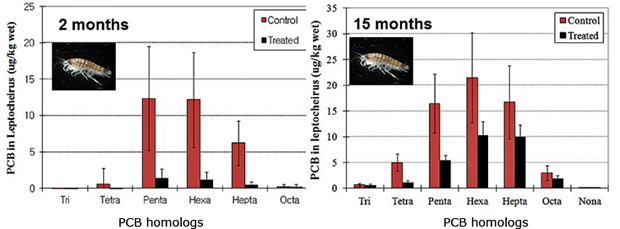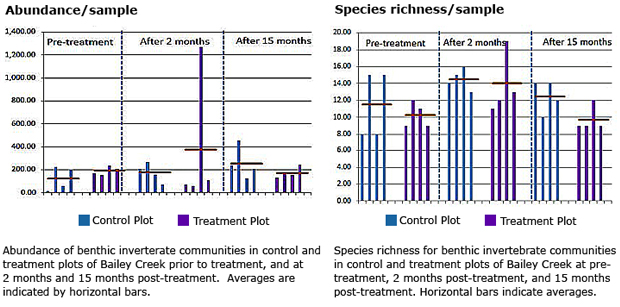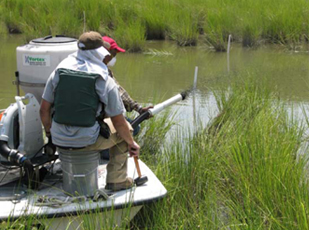|
Treatability Studies
A treatability study was conducted to determine the appropriate AC dose to apply to Bailey Creek sediments. Lab-scale bioaccumulation experiments using the marine benthic amphipod (Leptocheirus plumulosus) were conducted in PCB-contaminated untreated Bailey Creek sediment, and sediment treated with activated carbon amendment. Treated and untreated sediments were also exposed to passive samplers to measure changes in sediment porewater PCB concentration. A target dose of 5% AC was identified from these studies.
Engineering Specifications and Contracting
Engineering design, specifications, and construction at Bailey Creek was done by staff from the University of Maryland at Baltimore (UMB). Design and specifications for the project are in the Bailey Creek Demonstration Plan.
The Bailey Creek design involved two side-by-side plots (treated and untreated) in the creek covering an area of approximately 225 square meters. Each of the plots was subdivided into eight sub-plots for sampling. The biologically active zone was considered to be 10 cm (4 inches). Based on the treatability test results and previous experience with carbon dose at pilot test sites, the target does of AC was 5% dry weight. Calculations from the treatability study for dosing the treatment area of 225 m2 and a target thickness in the surficial sediment depth of 10 cm (4 in.) are presented below. The calculations include a 25 percent safety factor to result in a dosing rate of 3.4 kg SediMite™/ m2.

Placement Methods
Placement methods and site results are found in both the NIEHS Final Report, and are also discussed in the Final Report for Canal Creek (ER-200835).
AC as SediMite™ pellets was applied using a boat-mounted Vortex™ system (click here to view figure). The Vortex™ is a modular system composed of a 250-pound capacity polyethylene inductor hopper and a 2-stroke gasoline-powered blower unit. Pellets are loaded into the hopper, and an electric articulating valve releases the pellets from the bottom of the hopper and into a manifold. The pellets are blown from the manifold and through tubing that is aimed at the target of application. Two videos show the loading, and use of the Vortex system for spreading the SediMite™ (click here to go to the videos).
For the Bailey Creek treatment area the Vortex™ was mounted on the bow of a 21-foot Carolina Skiff. The boat was maneuvered into position outside one of the treatment-area subplots and held that position using anchors or by typing lines to poles that had been driven into the sediment to mark the plots. The amount of SediMite™ required to treat each subplot was loaded into the Vortex unit’s hopper and then distributed evenly onto the subplot. The treatment area included areas of both intertidal salt grass marsh and subtidal creek channel, and could be accessed by boat only during mid- to high tide. Therefore, the SediMite™ was broadcast over the surface water covering the treatment plots and settled to the sediment surface thereafter. The application required three people: a boat operator, an operator of the Vortex power unit, and an operator of the Vortex nozzle. The application was completed over two days due to the falling tide on the first day. The total amount of application time was approximately 4 hours.
Performance Monitoring
Activated Carbon Placement and Retention
Sediment cores collected on day two from the area treated on day one showed that some intact SediMite® pellets had penetrated the sediment to a depth of approximately 1 cm, effectively mixing into the surficial sediment by the inertia built during the descent through the water
 column. Sediment core samples collected at two months, and at 15-months post-placement indicate that most of the black carbon was in the upper 6 cm of the sediment.
column. Sediment core samples collected at two months, and at 15-months post-placement indicate that most of the black carbon was in the upper 6 cm of the sediment.
Two months post-application AC was within the targeted range; 70% of the mass of applied AC was estimated to be present. However, after 15 months the AC was only ~2.5% in upper 5 cm; 50% of the mass of the applied AC was present within the treatment area. AC was found in samples collected upstream and downstream of the test plots, suggesting that it least in part the material moved offsite with tidal currents.
Post-Treatment Monitoring
Bioaccumulation testing with Leptochirus.
The principal measure of efficacy for this study were the results from bioaccumulation studies with the Leptocheirus plumulosus. For Bailey Creek, PCBs in tissues were reduced by 90% after 2 months; reductions were ~50% after 15 months. The researchers suggest that this may be due to both loss of AC levels, as well as potential influx of PCBs from surrounding untreated sediments.

AC effects on native benthic infauna
The benthic invertebrate data were collected in Bailey Creek prior to treatment (August 2009), at 2 months following treatment (October, 2009), and at 15 months following treatment (November, 2010). Control and treatment plots were not significantly different prior to treatment for either richness or abundance indices in the two-month post-treatment measures. For 15-month post-treatment sampling there was a slight, but significant difference for species richness between the control and treatment plots. However, for the treatment plot, there was neither a significant difference between the pre- nor post-treatment abundance conditions after 15 months nor between the control plots for these sampling events. The benthic community composition was typical of brackish waters with a mix of polychaetes, tubificid oligochaetes, bivalves, and chironomid insect larvae.
The fauna at 15 months appeared to include more marine species than freshwater species.
The abundance of benthic invertebrates was not significantly different between the control and treatment plots prior to treatment or for either of the post-application monitoring events. There was no significant difference between the control plots prior to treatment and at 15 months after application; there was also no difference for the treatment plots. Overall, with the possibility that there might be slightly lower species richness in the treatment plots at 15 months, the studies indicate that the presence of AC in the range of 2.8–4.5% in the upper few centimeters does not adversely affect the benthic community.

Costs
A site-specific cost assessment was not done for the Bailey Creek project. The project costs were used in the preparation for the cost analysis done in association with the Canal Creek project (ER-200835)
|




 column. Sediment core samples collected at two months, and at 15-months post-placement indicate that most of the black carbon was in the upper 6 cm of the sediment.
column. Sediment core samples collected at two months, and at 15-months post-placement indicate that most of the black carbon was in the upper 6 cm of the sediment.


